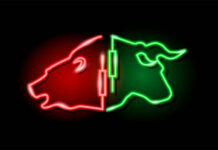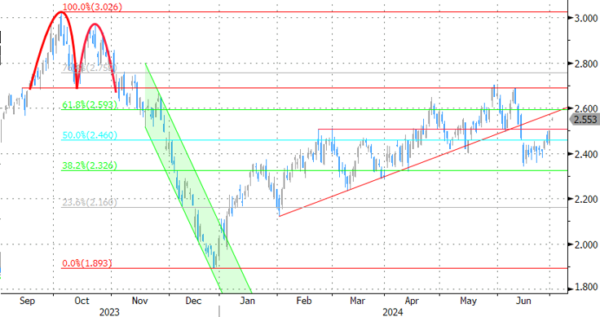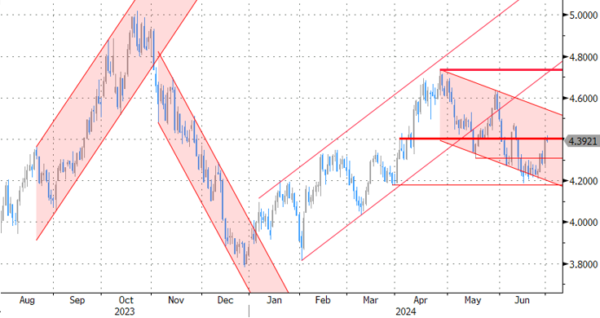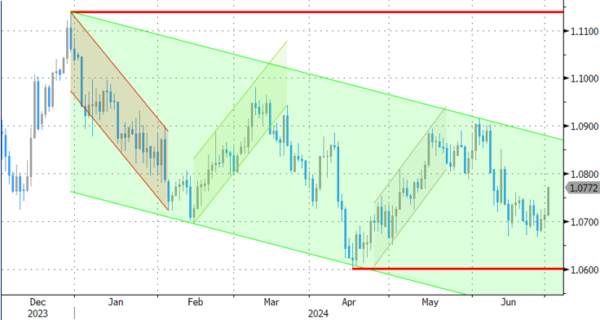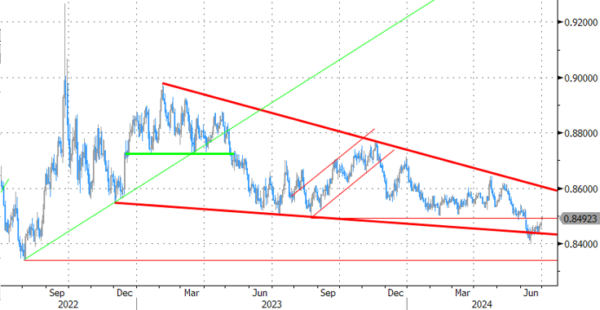Markets
Core bonds sold off into the final trading hours last Friday. We didn’t spot an obvious reason underpinning the move. Economic data (US PCE deflators, national inflation figures of certain EU member states) printed bang in line with expectations. But a looming weekend full of event risk (first round of French parliamentary elections) coinciding with the end of the quarter resulted in overall jittery markets. US Treasuries by the end of the day underperformed Bunds. Yields erased previous losses of as much as 4.5 bps to close between 4.2 (2-yr) and 13.3 (30-yr) bps higher. German yields added 2.6 to 5.5 bps across the curve. Stocks struggled in Europe. The French CAC40 underperformed (-0.7%). Wall Street turned south immediately after opening higher. The dollar and the euro balanced each other out. EUR/USD finished slightly higher north of 1.07. USD/JPY rose towards a new 34-yr high (160.88).
Yesterday’s outcome of the first round in the French parliamentary elections turned out to be in line with the polls. Le Pen’s Rassemblement National (RN) secured the most votes (33.3%) with the left-wing NFP coming in second (28.3%). Macron’s Ensemble (ENS) was third (21.3%). Some 75 MPs were already elected in the first round. Because of the exceptionally high voter turnout (67.5%) there are currently around 300 constituencies (representing 52% of the 577 seats) that potentially face a three-way run-off in the second round Sunday, July 7. Comparing this just one in 2017 and 8 in 2022 underscores the still high level of uncertainty after the first round. This number will probably go down a bit still amid suggestions from leaders of NFP and ENS for third-placed candidates to tactically withdraw in specific situations. But the local candidates do not always heed these calls. We’ll know about the final list of candidates by Tuesday evening. Both of the above parties already gave voter recommendations as well but here too a lot depends on how the public responds to them. In any case, it’s too soon to draw firm conclusions. However, based on the exit polls and this morning’s constructive market reaction, the probability of a hung parliament (where none of the extremes can push through its agenda via an absolute majority) seems to have increased. EUR/USD rises towards 1.076, European stock futures point to an opening rally of almost 2% and Bund yields are set for gapping higher. The economic calendar today features German inflation numbers ahead of tomorrow’s EMU print. ECB president Lagarde kicks off its Sintra conference with an introductory speech tonight. We have circled Wednesday in red, with “Drivers of equilibrium interest rates” as one of the hot topics.
News & Views
The Bank of International Settlements (BIS) encourages central bankers in its annual report to finish the last mile in restoring price stability. They set a high bar for policy easing, warning that premature action could reignite inflationary pressures and force a costly policy reversal. Services prices and wage growth are other upside risks. Falling export prices and waning Chinese demand are disinflationary forces. At the same time, governments have to step up by consolidating public finances and prioritizing long overdue structural reforms. Unrestrained public finances threaten macroeconomic and financial stability and make it also harder to bring inflation down.
The Bank of Japan’s Q2 Tankan survey boost the case for more gradual policy normalization (small rate hike) at its July meeting. Sentiment at large manufacturers improved from 11 to 13 (vs 11 consensus) while it marginally weakened for large non-manufacturers (33 from 34 as expected). Optimists also continue outnumbering pessimists on the outlook for the next quarter. Large firms across all industries on average want to increase their capital expenditures by 11.1% in the current fiscal year, suggesting back-to-back double digit growth (10.6% in previous fiscal year). Businesses see CPI inflation at 2.2% in 5 years’ time, up from 2.1% in the Q1 survey. More firms increased prices from the previous quarter and even more indicated that they plan to do so in the next quarter (especially non-manufacturing).
Graphs
GE 10y yield
The ECB cut its key policy rates by 25 bps at the June policy meeting. A more bumpy inflation path in H2 2024, the EMU economy gradually regaining traction and the Fed’s higher for longer US strategy make follow-up moves difficult. Markets are coming to terms with that. Meanwhile, some of the save haven bids were reversed after the first round in the French elections. The 2.34%-2.4% support zone looks a solid one.
US 10y yield
The Fed is seeking more evidence than just one slower-than-expected (May) CPI is providing. Upgraded inflation forecasts and a higher neutral rate complicate the exact timing of a first cut further. June dots suggest one move in 2024 followed by four more next year. Markets are positioned more aggressively, turning the recent low in yields into a technical support zone. A test of the downside of the 4.2/4.7% trading range was without consequences.
EUR/USD
EUR/USD is stuck in the 1.06-1.09 range. The desynchronized rate cut cycle with the ECB exceptionally taking the lead, strong US May payrolls and a swing to the right in European elections pulled the pair away from 1.09. The Fed meeting balanced the weaker than expected US CPI outcome. The increased probability of a hung French parliament after the first round offered the euro some relief.
EUR/GBP
Debate at the BOE is focused at the timing of rate cuts. May headline inflation returned to 2%, but core measures weren’t in line with inflation sustainably returning to target any time soon. Still some BoE members at the June meeting appeared moving closer to a rate cut. This might cap further sterling gains. The euro’s vulnerability to political event risk going into the French elections eased for now. EUR/GBP 0.84 is becoming solid support.
